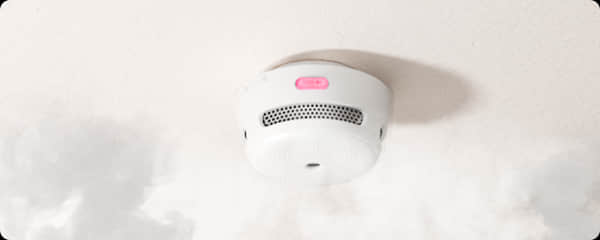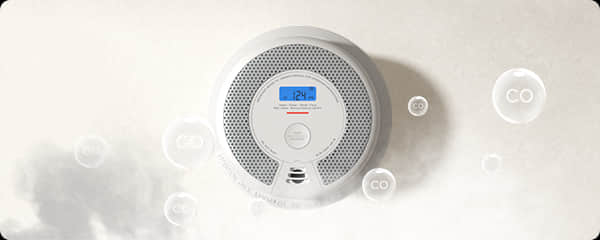Smoke Detector Connection: How to Wire Smoke Detectors
Thu, Jun 17, 2021
Smoke detectors should already be installed and maintained in our homes for safety purposes. But getting them installed is the first challenge. There are 2 types of smoke detectors, one that is battery powered and the other is hardwired. For hardwired ones, it may be tricky to figure out the smoke detector wiring if you are doing it the first time. If you think that you do not want to hassle yourself in wiring smoke detectors, you can opt to hire a professional. But, if you are willing to gain the experience, below is a guide to help you out.
Besides, we believe that you will not be in this article if you are not looking for a way to learn how to hardwire smoke detectors yourself. Especially during these challenging times, the concept of DIY has never been more prominent and exciting. Wiring smoke detectors yourself and being able to fulfill them brings a sense of achievement.
Knowing What to Do Before Smoke Detector Connection
Fire alarms wiring is pretty straightforward, but it can be challenging for beginners. Wiring smoke detectors can go easy if you have enough planning And, if you are a beginner, you need not be frightened. Learning how to hardwire smoke detectors is a task that has been tackled by many. Before linking the new smoke detector connection, you need to understand what you are facing. There is typically an old electrical installation that you must locate and check. Before doing this, make sure that your electrical power is shut off to avoid accidents.

Preparing What You Need
- To work on the smoke detector connection, you would need the right materials.
- Voltage tester.
- Wire stripper and connectors (3 will be installed per device).
- Drywall saw and cordless drill.
- 12-2, 12-3 NMB cable and ground wire.
- Ladder.
- Old work electrical box.
- Smoke detector device.
Below is a quick step guide on how to wire smoke detectors. Hopefully, by the end of this, you will know how to hardwire smoke detectors yourself:
Switch off the main electrical power
The smoke alarm wiring is “hard-wired” which means that it relies on the main electricity power of the house. You need to turn off the power source so you can work on the installation safely. Fire alarms wiring in this case will be connected to the power line of the house. If you are confident that the switch for this is isolated, you can go to your electrical box and switch it off. But if you are not sure, then it is best to just turn off the whole power switch. After this, wait a while and use your voltage meter detector, and place it on the exposed end of the smoke alarm wiring. This way, you can be sure whether the electricity is still live or already safe to work with.
Install the electrical box to house the unit
Use the electrical box to trace the hole so that you can drill precisely on the walls. For beginners, it may help if you first make a template or cutouts so that you can understand where the openings will be. This helps avoid erroneous drill holes. If the electrical boxes already exist because you are replacing an old one, then you can simply reuse them. Need no drill further holes. But if you are creating a place, you need to find the best place for the alarm. Ideally, the ceiling is a good place.
Place the wire
The ground wire will run from the power source to the smoke detector. There can be an existing fire alarms wiring which you can use. But there has to be enough extension left. So be careful when you trim them down. Wiring smoke detectors can leave you with a couple of long twines which you can do a “pigtail” to keep it neat. But this can only be done after you have everything in place, and just before you close everything. Electricians will often do this, and it would be beneficial for you to learn it as part of learning how to wire smoke detectors.
Get the smoke detector connection and attach the wires
Each box unit should have enough wire length to put through the hole. Simply use the cable strip wire and clamp them to the electrical box. Smoke detector wiring will require you to simply align the cable colors. Black will be connected with black, white will be linked with white and the red will be attached to the other red cable. Should only 2 wires be existing, you can connect those matching 2 and leave the other one with a secured clamp.
Attach the smoke alarm wiring securely
Once secured, then you can move forward to mounting the electrical box to the drywall. Wiring multiple devices follow the same process as well. To mount the box, tightly screw them in place. The screws usually come with the device so there is no need to source the item.
Install the smoke detector and connect the fire alarms wiring
Your smoke detector will contain the device itself and the mounting device. To address the smoke detector wiring, you will need to connect the wiring harness and the wires through the electrical box.
Assemble everything
Connect the mounting plate and screws and attach the back of the smoke alarm to the plate. You should feel the snug snap when you twist them in place to make sure that the unit is will not go anywhere.
Power on the circuit
With the wires in place, you can now set the power back. You will know when you have the wiring smoke detectors correctly installed when the smoke alarm powers on. Make sure you test them as well. If everything works well, then it becomes a testament that you now know how to hardwire smoke detectors.
Post-installation Activities

Test the smoke alarm wiring by powering on the alarm
Even though you already have things in place, there are a few more steps to do after installation. This further ensures that the smoke detector connection will continuously work. The first step to do in this case is to test the alarm. Your smoke detectors have a built-in test feature that should beep when pressed for a few seconds. A beeping sound should alarm and this lets you know that it is working correctly.
Monitor your smoke alarm once a week for a month
By doing this, you can be sure that the circuit wiring that you built is working fine and will continue to work for the long term. This is an important step for beginners who previously did not know how to wire smoke detectors. Monitoring involves testing the smoke detector if it is still working. The step is similar to the previous step.
Calling a professional
Ideally, calling a service professional will not be necessary if you have managed to secure the smoke detector connection yourself. But we can’t help it that there are scenarios where the smoke alarm wiring will be faulty if especially when you are not fully confident at first. The smoke detector wiring could also work the first time but not last. And if this happens, it may be complicated to try and figure out for yourself.
Thus, needing to call a professional should get you out of the rut. Another option if you want to involve a service professional – is early on. This way, you can get them to teach you the basics of how to hardwire smoke detectors, and perhaps the rest is something you can do. Again, the smoke detector wiring tends to be straightforward for experienced installers so it should help get beginners a better view of how things should be done. And in the end, lessens the possibilities of complications.
Conclusion
Learning how to wire smoke detectors may seem like a daunting task at first, but it is not impossible to do. With the internet and its many information, people like you can do this on your own. Just make sure that you take the necessary precautions when performing smoke detector wiring because of the risk of electrocution or electrical shorting. When in doubt, you can always leverage a service professional to help you out and establish fire alarms wiring for you. But you are not here for that. And with that, we hope that by the end of this you will be confident and successful in learning how to wire smoke detectors.

X-Sense XS01-WR Wireless Smoke Detector
- Wireless technology uses radio frequency to transmit and receive messages.
- If one alarm goes off, the rest of the interconnected alarms will alert as well.
- 5-year replaceable battery and 10-year sensor life.
- Advanced photoelectric sensor is more sensitive and reduces false alarms.
$35.99











